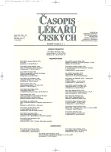Prediction in medicine – genome contra envirome
Authors:
Radim Brdička
Authors‘ workplace:
Ústav experimentální medicíny AV ČR, Praha
Published in:
Čas. Lék. čes. 2012; 151: 22-25
Category:
Special Articles
Overview
Human phenotype is governed by its genotype – a set of genetic information materialized in DNA. Using traditional terminology we speak about a little more than 20 thousands genes that differ in strength to become realized and their effect is modified by a large number of other genes. The result originates from firmly established programmes we obtained from our ancestors. Development and activity of such molecules selected for maintenance, copying and transfer of information i.e. nucleic acids can be followed back to the very origin of the life. Nevertheless the final result is achieved not only by confrontation of the original information with other genetic information but largely also by external influences – environment. Though we are relatively successful in understanding what we have inherited from our parents, our knowledge of environmental factors and their effects on formation of the phenotype is still limited. From this point of view medical prediction has always to be very cautious and interpretations at the probability level must be done by a very experienced and responsible professional.
Key words:
genome, genotype, phenotype, toxicogenomics, epigenetics, mutation, penetrance, pleiotropy, monogenic inheritance, multifactorial inheritance, genetic risk.
Sources
1. Ku C-S, Naidoo N, Pawitan Y. Revisiting Mendelian disorders through exome sequencing. Human Genetics 2011; 129 : 351–370.
2. Kang PB. Presymptomatic and early symptomatic genetic testing CONTINUUM. Lifelong Learning in Neurology 2011; 17 : 343–346.
3. Hudson KL, Holohan MK, Collins FS. Keeping pace with the times – The Genetic Information Nondiscrimination Act of 2008. N Engl J Med 2008; 358 : 2661–2663.
4. Erwin C, Williams JK, Juhl AR, et al. I-RESPOND-HD Investigators of the Huntington Study Group. Perception, experience, and response to genetic discrimination in Huntington disease: the international RESPOND-HD study. Am J Med Genet B Neuropsychiatr Genet 2010; 153B(5): 1081–1093.
5. Syurina EV, Brankovic I, Probst-Hensch N, Brand A. Genome-Based Health Literacy: a new challenge for Public Health Genomics. Public Health Genomics 2011; 14 : 201–210.
6. Urbach D, Moore JH. Mining the diseasome. BioData Mining 2011; 4 : 25.
7. Kann MG. Advances in translational bioinformatics: Computational approaches for the hunting of disease genes. Briefings in Bioinformatics 2009; 11 : 96–110.
8. Oti M, Ballouz S, Wouters MA. Web tools for the prioritization of candidate disease genes. Methods in Molecular Biology 2011; 760 : 189–206.
9. Capriotti E, Altman RB. A new disease-specific machine learning approach for the prediction of cancer-causing missense variants. Genomics 2011; 98 : 310–317.
10. Chen JM, Férec C, Cooper DN. Revealing the human mutome. Clinical Genetics 2010; 78 : 310–320.
11. Ogawa T, Rakwal R, Shibato J, et al. Seeking gene candidates responsible for developmental origins of health and disease. Congenital Anomalies 2011; 51 : 110–125.
12. Jo Y, Koh IS, Bae H, Hong M-C, Shin M-K, Kim YS. TOXPO: TOXicogenomics knowledgebase for inferring toxicity based on POlymorphism. Biochip Journal 2010; 4 : 99–104.
13. Chen D, Pan X, Xiao P, Farwell MA , Zhang B. Evaluation and identification of reliable reference genes for pharmacogenomics, toxicogenomics, and small RNA expression analysis. Journal of Cellular Physiology 2011; 226 : 2469–2477.
14. Afman L, Müller M. Nutrigenomics: From molecular nutrition to prevention of disease. Journal of the American Dietetic Association 2006; 106 : 569–576.
15. Stover PJ, Caudill MA. Genetic and epigenetic contributions to human nutrition and health: managing genome-diet interactions. Journal of the American Dietetic Association 2008; 108 : 1480–1487.
16. Arai Y, Ohgane J, Yagi S, et al. Epigenetic assessment of environmental chemicals detected in maternal peripheral and cord blood symplex. Journal of Reproduction and Development 2011; 57 : 507–517.
17. Groom A, Elliott HR, Embleton ND, Relton CL. Epigenetics and child health: Basic principles. Archives of Disease in Childhood 2011; 96 : 863–869.
18. Suter M, Ma J, Harris AS, et al. Maternal tobacco use modestly alters correlated epigenome-wide placental DNA methylation and gene expression. Epigenetics 2011; 6: (Epub ahead of print).
19. Votavova H, Dostalova Merkerova M, Fejglova K, et al. Transcriptome alterations in maternal and fetal cells induced by tobacco smoke. Placenta 2011; 32 : 763–770.
20. Vaiserman AM. Hormesis and epigenetics: Is there a link? Ageing Res Rev 2011; 10 : 413–421.
21. Suhre K, Shin S-Y, Petersen A-K, et al. Human metabolic individuality in biomedical and pharmaceutical research. Nature 2011; 477 : 54–62.
22. Sadee W. Genomics and personalized medicine. International Journal of Pharmaceutics 2011; 415 : 2–4.
23. Cai T, Tonini G, Lin X. Kernel machine approach to testing the significance of multiple genetic markers for risk. Prediction Biometrics 2011; 67 : 975–986.
24. Janssens ACJW, Ioannidis JPA, Bedrosian S, et al. Strengthening the reporting of genetic risk prediction studies (GRIPS): explanation and elaboration. European Journal of Clinical Investigation 2011; 41 : 1010–1035.
25. Bloss CS, Schork NJ, Topol EJ. Effect of direct-to-consumer genomewide profiling to assess disease risk. N Engl J Med 2011; 364 : 524–534.
Labels
Addictology Allergology and clinical immunology Angiology Audiology Clinical biochemistry Dermatology & STDs Paediatric gastroenterology Paediatric surgery Paediatric cardiology Paediatric neurology Paediatric ENT Paediatric psychiatry Paediatric rheumatology Diabetology Pharmacy Vascular surgery Pain management Dental HygienistArticle was published in
Journal of Czech Physicians

- Metamizole at a Glance and in Practice – Effective Non-Opioid Analgesic for All Ages
- Advances in the Treatment of Myasthenia Gravis on the Horizon
- Metamizole vs. Tramadol in Postoperative Analgesia
- Possibilities of Using Metamizole in the Treatment of Acute Primary Headaches
- Metamizole in perioperative treatment in children under 14 years – results of a questionnaire survey from practice
Most read in this issue
- The history of medicine in the ancient time
- Catheter related blood stream infections – prevalence and interventions
- Statin-ezetimibe combination in hyperlipidemia treatment
- Endoscopy simulator for training in digestive endoscopy
